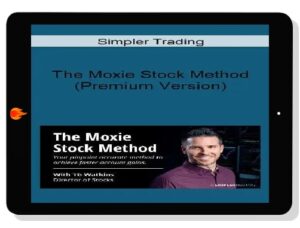FXEvolution – Technical Analysis MasterClass
FXEvolution – Technical Analysis MasterClass course is now available at an affordable price. You can check out directly using multiple payment gateway options. If you have any questions or need an alternative payment method, feel free to contact us.
Description
Description
Original website: https://www.fxevolution.com/
Original price: $1,500
Content: full course







Price analysis is often overlooked by traders looking for trading opportunities, but price is the most important leading indicator available to help identify the next market move. The Price & Trend Analysis module teaches you the important components of this style of trading including identifying and interpreting candlestick patterns, locating price trends within the charts and applying multi-timeframe chart analysis.
Section 1 – Candles and bars
What you’ll learn:
The types of charts that are available on most platforms
The components that make up candles and bars
How to identify the most popular candlestick patterns
How to interpret closes on a bar
Section 2 – Price trends
What you’ll learn:
How to identify short-term trends that form inside price
The trading conditions that do not cause a change of trend
How to identify long-term trends that form inside price
How to identify a change of a long-term trend
Section 3 – Multi time-frame analysis
What you’ll learn:
How to interpret large timeframe candles on smaller charts
How to understand the buyer and seller dynamics across different timeframes
The importance of candle close confirmations
How to interpret multi-timeframe chart analysis
Section 4 – Candlestick patterns
What you’ll learn:
How to identify Engulfing candlestick patterns
How to identify Star candlestick patterns
How to identify Harami candlestick patterns
How to identify reversal candlestick patterns
Trading any type of financial markets comes with different types of challenges, with some being unique to particular instruments, and others more universal. The charting techniques module uncovers tools that can be used in any type of market and trading condition which can give you the capability to apply your learning to your favourite trading instruments and timeframes.
Section 1 – Support & Resistance
What you’ll learn:
How to identify and trade horizontal support
How to identify and trade horizontal resistance
How support and resistance can work together
How to identify and trade role reversal zones
Section 2 – Trend lines
What you’ll learn:
How to identify a trend line in an uptrend
How to validate a trend line in an uptrend
How to identify a trend line in a downtrend
How to validate a trend line in a downtrend
Section 3 – Channels
What you’ll learn:
How to identify and trade horizontal channels
How to identify and trade ascending channels
How identify and trade descending channels
How to trade channel breakouts
Section 4 – Fibonacci Retracements
What you’ll learn:
What the Fibonacci numbers are and why they are important
How to interpret and use Fibonacci Retracements in an uptrend
How to interpret the most optimal Fibonacci Retracement zones
How to interpret and use Fibonacci Retracements in a downtrend
I’m sure most traders have heard of some of the most popular chart patterns in the market, and many remain mystified as to why these popular patterns are so successful for some people, but appear like failures to others. This module will show you how to not only identify the quality patterns as they form, but also how to trade them accurately.
Section 1 – Double tops and patterns
What you’ll learn:
How to identify a double top formation
The best way to trade a double top
How to identify a double bottom formation
The best way to trade a double bottom
Section 2 – Head and shoulders patterns
What you’ll learn:
How to identify and trade head & shoulders formations
The best way to trade a head and shoulders
How to identify an inverse head and shoulders
The best way to trade an inverse head and shoulders
Section 3 – Triangle patterns
What you’ll learn:
How to identify and trade symmetrical triangle patterns long
How to identify and trade symmetrical triangle patterns short
How to identify and trade ascending triangle patterns
How to identify and trade descending triangle patterns
Section 4 – Flag and pennant patterns
What you’ll learn:
How to identify flag patterns in uptrends and downtrends
How to trade flag patterns in the real market
How to identify pennant patterns in uptrends and downtrends
How to trade pennants in the real market
There are literally hundreds of different indicators available to traders looking for an edge when trading the markets. Some offer proprietary entry and exit levels, whilst others attempt to predict the next direction of the market, or when a market may reverse. The indicators in this module are the ones I have found work the best with my trading style, and best fit the market conditions I like to trade.
Section 1 – Moving averages
What you’ll learn:
How to understand the differences in moving averages
How to determine trend direction using moving averages
How to use moving averages for dynamic support
How to use moving averages for dynamic resistance
Section 2 – MACD
What you’ll learn:
What the MACD indicator represents and how it forms
How to interpret the MACD indicator
How to trade MACD crossovers
How to interpret and trade MACD divergence
Section 3 – Stochastic oscillator
What you’ll learn:
How to trade the simple stochastic method
How to trade the stochastic crossover method
How to trade the stochastic trending method
How to interpret and trade stochastic divergence
Section 4 – Relative strength index
What you’ll learn:
How to establish a trend bias using RSI
How to trade RSI in the direction of a trend
How to identify and trade RSI failure swings
How to interpret and trade RSI divergence
Section 5 – Bollinger bands
What you’ll learn:
How to interpret the different Bollinger Band deviations
The rules for trading the Bollinger Bands indicator
How to use Bollinger Bands during extreme moves
How to interpret and trade Bollinger Band divergence
In this module you will learn advanced trading concepts that can be applied to trending and range-bound markets to help increase the quality and profitability of your trades. The Advanced Techniques module teaches you to combine several technical analysis concepts to build adaptable and measurable trade plans to take your trading to a professional standard.
Section 1 – Joining Existing Trends
What you’ll learn:
How to use double top chart patterns to join an existing downtrend
How to use double bottom chart patterns to join an existing uptrend
How to trade potential double top and double bottom patterns
How to use candlestick patterns to confirm entry points
Section 2 – Confirming Entry Levels
What you’ll learn:
How to apply Fibonacci levels to confirm patterns in existing trends
How to use trend lines to help determine the strength of existing trends
How to apply the MACD indicator to strengthen the validity of the patterns
How to use the Bollinger Bands indicator to assess the reliability of the patterns
Section 3 – Multi Time-frame
What you’ll learn:
How to use double top chart patterns to join an existing downtrend
How to use double bottom chart patterns to join an existing uptrend
How to trade potential double top and double bottom patterns
How to use candlestick patterns to confirm entry points
Section 4 – Points Based Trading System
What you’ll learn:
The components required to build the PRECIC points-based trading system
How to rate each score of the PRECIC trading system
How the elements of the PRECIC trading system work together
How to identify the elements of the PRECIC trading system
Section 5 – Trading Rangebound Markets
What you’ll learn:
How to identify rangebound markets using channels and triangles
Key indicators to identify rangebound markets
Chart patterns to use at the top of a rangebound market
Chart patterns to use at the bottom of a rangebound market
Section 6 – Trading Inside a Range
What you’ll learn:
The benefits of trading inside a rangebound market
How to trade Double Top chart patterns in the middle of a range
How to trade Double Bottom chart patterns in the middle of a range
How to scalp potential Double Top and Bottom patterns inside a range
Trading psychology and risk management are the most important factors that will determine your success as a trader. Contrary to the belief of most aspiring traders, having a trading system with excellent signals is not enough to ensure your long-term success. In fact, many great trading systems fail when they otherwise shouldn’t due to a lack of risk management by traders. The Trade Management module will show you how to manage risk, as well as how to apply the correct psychological approach to your trading plans.
Section 1 – Types of Orders
What you’ll learn:
The six order types available to traders
How to place trades using market orders
How to place trades using limit orders
How to place trades using stop orders
Section 2 – Stop Loss & Take Profit Zones
What you’ll learn:
The golden rules of stop loss and take profit zones
Where to place stop loss and take profit zones for channels and topping patterns
Where to place stop loss and take profit zones for triangles, flags and pennants
How to use dynamic stop loss levels in trends
Section 3 – Position Sizes & Leverage
What you’ll learn:
How to interpret position sizing
How to break down a position size to a dollar value
The mechanics of how leverage works
How to understand and use leverage
Section 4 – The Psychology of Trading
What you’ll learn:
The emotions that you can expect to encounter when trading
How to manage the individual risk of each trade
The importance of good reward to risk ratios
What behaviours to avoid when placing trades
Delivery Policy
When will I receive my course?
You will receive a link to download/view your course immediately or within 1 to 24 hrs. It may takes few minutes, also few hours but never more than 24 hrs. Due to different time zone reasons.
How is my course delivered?
We share courses through Google Drive, so once your order is complete, you’ll receive an email with a google drive folder access link to view the course in your email.
To avoid any delay in delivery, please provide a Google mail and enter your email address correctly in the Checkout Page.
In case you submit a wrong email address, please contact us to resend the course to the correct email.
Where can I find my course?
Once your order is complete, a link to download/view the course will be sent to your email.







